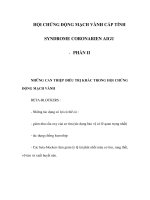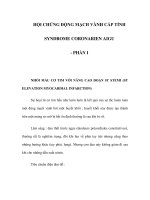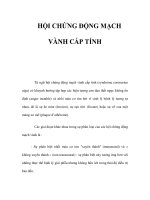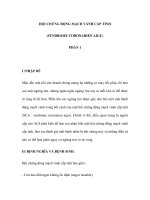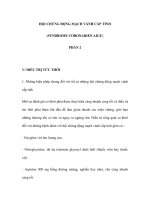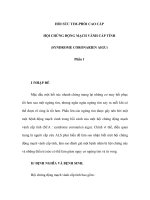Chiến lược tái thông mạch vành trong hội chứng vành cấp
Bạn đang xem bản rút gọn của tài liệu. Xem và tải ngay bản đầy đủ của tài liệu tại đây (2.09 MB, 30 trang )
14th Vietnam National Congress of Cardiology
Da Nang, Vietnam
October 11-14, 2014
Acute Coronary Syndromes
Reperfusion Strategies
Gregory W. Barsness, MD, FACC, FAHA, FSCAI
Director, Mayo Clinic Cardiac Intensive Care Unit
Director, Mayo Clinic EECP Laboratory
©2013 MFMER | slide-1
Disclosures
No pertinent financial conflicts
Off-label Usage:
DES in ACS
©2013 MFMER | slide-2
ACS Epidemiology
Proportion of STEMI vs NSTE-ACS
> 5 million ED visits for chest pain
1.57 million admissions for ACS
(1 MI every 44 seconds in US)
~ 70% of all acute MI are NSTEMI
100
NSTEMI
STEMI
Percent
80
60
40
20
0
1999
2000
2001
2002
2003
2004
2005
Year
Chan, et al. Circ 2009;119
2013 AHA Heart and Stroke Statistics, cardiosource.org
©2013 MFMER | slide-3
All-Cause Mortality in STEMI vs NSTEMI
4606 AMI Pts Undergoing Angiography
70
Mortality (%)
60
NSTEMI
50
40
30
STEMI
20
10
0
0
1
2
3
4
Years
5
6
7
8
Chan, et al. Circ 2009;119
©2013 MFMER | slide-4
Therapy in NSTE-ACS is Complex
Anticoagulants: UFH LMWH Fondaparinux Bivalirudin
Antiplatelets:
ASA Clopidogrel Prasugrel
(dose)
(dose)
Ticagrelor
IV antiplatelets: None Abciximab Eptifibatide/Tirofiban
Cath strategy:
Early
Delayed
Never
144 Different Combinations with
different effects on bleeding and
thrombosis risk!
©2013 MFMER | slide-5
Guideline Adherence and Outcome
In-hosp mortality (%)
7
6
5.95
5.16
5
4
3
Adjusted
Unadjusted
6.33
5.07
4.97
4.63
4.16
4.17
Every 10% in guidelines adherence
2
11% in mortality
1
0
<=25%
25-50%
50-75%
>=75%
Hospital composite quality quartiles
Peterson, et al. ACC 2004
©2013 MFMER | slide-6
Early-Invasive vs Delayed-Invasive
(Ischemia-Guided) Strategy
ISAR-COOL
ICTUS
VANQWISH
(1998)
(2005)
MATE
TIMI III-B
RITA-3
(2002)
TRUCS
(1994)
VINO
TACTICS25% Relative Mortality Risk Reduction
TIMI 18
Over 2 Years!
FRISC II
(2001)
(1999)
Weight of
the evidence
Favors “Conservative”
n=920
No difference
n=2,874
Favors Early Invasive
n=7,018
©2013 MFMER | slide-7
Timing of Intervention in ACS (TIMACS)
Early (<24hr) vs Delayed (>36)
Kaplan-Meier Cumulative Risk of the Death, MI or Stroke
Stratified by Baseline GRACE Risk Score: Low (≤140) vs High Risk (>140)
0.25
Delayed
Cumulative Hazard
High Risk
Early
Early
Delayed
Low-toIntermendiate
Risk
0.00
0
Early intervention (med 14 hrs)
90
Days
180
Delayed intervention (med 50 hrs)
Mehta SR et al. NEJM 2009;360:2165-2175
©2013 MFMER | slide-11
Timing of Intervention in ACS (TIMACS)
Early (<24hr) vs Delayed (>36)
Kaplan-Meier Cumulative Risk of the Death, MI or Stroke
Stratified by Baseline GRACE Risk Score: Low (≤140) vs High Risk (>140)
0.25
Delayed
Cumulative Hazard
High Risk
Early
I IIa IIb III
0.00
0
Early intervention (med 14 hrs)
90
Days
180
Delayed intervention (med 50 hrs)
Mehta SR et al. NEJM 2009;360:2165-2175
©2013 MFMER | slide-12
ABOARD
Immediate vs Delay Angio in High-Risk ACS
Peak Troponin I *
30-Day MACE
30-Day Major Bleeding
16
13.7
14
12
10.2
10
8
6.8
6
4
2
4
2.1
1.7
0
Immediate (Mean 70 Min)
*Primary Endpoint
n=352
All p=NS
Delayed (Mean 21 Hrs)
Montalescot, et al. JAMA 2009;302:947
©2013 MFMER | slide-13
Non ST Elevation ACS
Management Strategies
Definite/Possible ACS
Initiate Aspirin, Beta-blockers (PO), Nitrates, Anticoagulants, Telemetry
Early Invasive Strategy
•Electrical or hemodynamic instability
•Refractory, resistant, recurrent angina
•Elevated Risk Score (GRACE>140, TIMI>2)
•Abnormal biomarkers (20% change)
•New ST segment depression
•PCI in past 6 months or prior CABG
•DM or CKD (Stage II or III)
•EF <40%
•Mod Risk Score (GRACE 109-140,TIMI ≥ 2)
Coronary angiography
Within 2 Hours
ACC/AHA Guidelines UA/NSTEMI 2014
©2013 MFMER | slide-14
Non ST Elevation ACS
Management Strategies
Definite/Possible ACS
Initiate Aspirin, Beta-blockers (PO), Nitrates, Anticoagulants, Telemetry
Early Invasive Strategy
•Electrical or hemodynamic instability
•Refractory, resistant, recurrent angina
•Elevated Risk Score (GRACE>140, TIMI>2)
•Abnormal biomarkers (20% change)
•New ST segment depression
•PCI in past 6 months or prior CABG
•DM or CKD (Stage II or III)
•EF <40%
•Mod Risk Score (GRACE 109-140,TIMI ≥ 2)
Coronary angiography
Within 24 hours
ACC/AHA Guidelines UA/NSTEMI 2014
©2013 MFMER | slide-15
Non ST Elevation ACS
Management Strategies
Definite/Possible ACS
Initiate Aspirin, Beta-blockers (PO), Nitrates, Anticoagulants, Telemetry
Early Invasive Strategy
•Electrical or hemodynamic instability
•Refractory, resistant, recurrent angina
•Elevated Risk Score (GRACE>140, TIMI>2)
•Abnormal biomarkers (20% change)
•New ST segment depression
•PCI in past 6 months or prior CABG
•DM or CKD (Stage II or III)
•EF <40%
•Mod Risk Score (GRACE 109-140,TIMI ≥ 2)
Coronary angiography
25-72 Hours
ACC/AHA Guidelines UA/NSTEMI 2014
©2013 MFMER | slide-16
Non ST Elevation ACS
Management Strategies
Definite/Possible ACS
Initiate Aspirin, Beta-blockers (PO), Nitrates, Anticoagulants, Telemetry
Early Invasive Strategy
•Electrical or hemodynamic instability
•Refractory, resistant, recurrent angina
•Elevated Risk Score (GRACE>140, TIMI>2)
•Abnormal biomarkers (20% change)
•New ST segment depression
•PCI in past 6 months or prior CABG
•DM or CKD (Stage II or III)
•EF <40%
•Mod Risk Score (GRACE 109-140,TIMI ≥ 2)
Coronary angiography
Ischemia-Guided Strategy
• TIMI Risk Score ≤2 (Especially Tn- Women!)
• No ST segment deviation
• Negative biomarkers
Recurrent Symptoms
Heart failure
Serious Arrhythmia
Worsening MR
EF<40%
+
Stable
Assessment of EF
Stress Test
ACC/AHA Guidelines UA/NSTEMI 2014
©2013 MFMER | slide-17
Non ST Elevation ACS
Management Strategies
Definite/Possible ACS
Initiate Aspirin, Beta-blockers (PO), Nitrates, Anticoagulants, Telemetry
Early Invasive Strategy
•Electrical or hemodynamic instability
•Refractory, resistant, recurrent angina
•Elevated Risk Score (GRACE>140, TIMI>2)
•Abnormal biomarkers (20% change)
•New ST segment depression
•PCI in past 6 months or prior CABG
•DM or CKD (Stage II or III)
•EF <40%
•Mod Risk Score (GRACE 109-140,TIMI ≥ 2)
Coronary angiography
12-48 Hours
Ischemia-Guided Strategy
• TIMI Risk Score ≤2 (Especially Tn- Women!)
• No ST segment deviation
• Negative biomarkers
Recurrent Symptoms
Heart failure
Serious Arrhythmia
Worsening MR
EF<40%
+
Stable
Assessment of EF
Stress Test
ACC/AHA Guidelines UA/NSTEMI 2014
©2013 MFMER | slide-18
STEMI Management Algorithm
Www.
www.cardiosource.org
©2013 MFMER | slide-20
35-Day Mortality Reduction with Thrombolysis
58,600 Patients – 9 Trials
30
Mortality (%)
P<0.00001
18%
reduction
20
Thrombosis
23.6
Placebo
18.7
16.9
15.2
13.4
13.2
11.5
10
13.8
10.6
9.6
7.5
8.4
0
Total
BBB
Ant MI
Inf MI
Other ST
-
ST ¯
FTT: Lancet, 1994
©2013 MFMER | slide-21
Primary PCI vs. Fibrinolysis
Meta-analysis of 23 RCTs of 7739 pts
NNT = 50
NNT = 17
4-6 week outcomes
25
21
PCI
20
Lysis
15
%
10
13
7
9
5
7
7
6
2.2
1
2
0
Death
Re-MI
Rec
Isch
Total
stroke
0
8
5
1
Hem
stroke
Major
bleed
Death
MI
Stroke
Keeley and Grines. Lancet 2003.
©2013 MFMER | slide-22
Early PCI after Lysis
“Pharmaco-Invasive” Strategy
Ischemic Endpoint, %
30
Routine PCI
24.4
Selective PCI
21.2
20
11.6
20.3
No excess in major bleeding
17.1
with routine PCI
10.7
10
10
11
9.3
4.4
0
CAPITAL-AMI
1.6
CARESS-inAMI
NORDISTEMI
TRANSFER
AMI
2.3
<3.0
3.9
Fibrinolysis to routine PCI (h)
GRACIA I
16.7
Adapted from Verheugt, NEJM 2009
©2013 MFMER | slide-23
Non-PCI Hospital Triage and Transfer
Symptom Onset
Symptoms
<2-4 hours
Low
Bleeding risk
Fibrinolytic with
Antithrombin + clopidogrel
Symptoms
>2-4 hours
High
Transfer for
PPCI
Transfer for PCI 3-16 hours
©2013 MFMER | slide-24
Minnesota
0
100
200
Wisconsin
Minneapolis/
St. Paul
Rochester
Iowa
©2013 MFMER | slide-25
Mayo NSTE-ACS Protocol
Tools:
ECG within 10 min, repeat q 15-30 min
Biomarkers (Troponin), repeat 3-6 hrs
Risk scores (TIMI, Grace)
©2013 MFMER | slide-26
Mayo NSTE-ACS Protocol
©2013 MFMER | slide-27
Mayo NSTE-ACS Protocol
©2013 MFMER | slide-28
©2013 MFMER | slide-29



